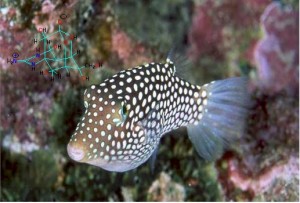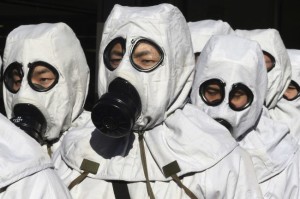Top 10 Most Deadliest Substance Known To Man
Toxic substances include anything that can physically harm us after we inhale, swallow or touch it, from an innocent bee sting to full-blown cyanide poisoning.
Defining toxicity is tricky since almost anything is poisonous at high enough doses – even water. Acute poisoning follows just one exposure, for example, nibbling a death cap mushroom, but chronic exposure – like inhaling cigarette smoke over decades – can be equally, if not more, damaging.
Toxins are toxic substances produced by living organisms. They use toxins mainly to ward off predators or paralyse prey. Small but deadly bacteria produce some of the most potent toxins known, including botulinum toxin A (Botox).
Other toxic substances occur naturally on Earth, such as the hydrogen sulphide produced by volcanic eruptions. We humans have even invented man-made ones for use as pesticides, insecticides (eg DDT) or chemical weapons (eg sarin, VX).
Targeting different parts of the body, toxic substances can damage us in an alarming number of ways. Neurotoxins are some of the most effective, affecting the brain and nervous system and causing muscles to freeze or twitch uncontrollably. Other substances can burst our red blood cells or cause allergic reactions.
But not everyone is affected by toxic substances in the same way. How toxic a chemical is depends on how easily it is absorbed, metabolised and eventually expelled by the body. Children are generally more vulnerable as their bodies are not able to get rid of toxic substances as effectively.
Different species are also more or less susceptible to various poisons – for example, it takes 1,000 times more dioxin to kill a hamster than a guinea pig.
Check our TOP 10 list of most deadliest substances known to man:
![Botox]() 1. Botox
1. Botox
This is the most toxic substance in nature: just one gram (0.04 ounces) could kill 14,000 people if swallowed – or 8.3 million if injected!
Produced by Clostridium botulinum bacteria, this neurotoxin is responsible for botulism, a rare but life-threatening illness transmitted principally through contaminated canned food.
Botulinum disrupts communication between nerves and muscle cells, gradually paralysing its victims and finally leading to respiratory failure. Extremely small doses of botulinum toxin can, however, be used to treat muscle spasms and excessive sweating and to paralyse the muscles that cause wrinkles (sold commercially as Botox).
2. Asbestos
Asbestos is the name given to a handful of different minerals which share one common feature: bunches of fibrous crystals. Boasting an array of insulating properties topped off with a low price tag, asbestos was a popular building material until its toxic effects came to light.
With repeated inhalation, asbestos fibres accumulate in the lungs, causing deadly diseases like asbestosis, an inflammatory lung condition, and cancer. These diseases typically don’t develop until 15-30 years after exposure.
![Ricin]() 3. Ricin
3. Ricin
Found in the castor oil plant, ricin is a toxic protein that wreaks havoc on ribosomes, the cell’s protein builders.
The result is severe damage to major organs. Just one milligram of ricin is enough to kill an adult if inhaled or ingested, leading many countries to investigate its use as a biological weapon.
The castor oil plant’s popularity as an ornamental shrub and the relative ease of extracting the toxin from castor beans have also made ricin the poison of choice for many assassins.
4. Carbon monoxide
Colourless and odourless, carbon monoxide gas has a knack for going unnoticed.
It is produced by the incomplete combustion of organic fuels including gas, coal and wood – occurring, for example, when inadequate ventilation deprives a gas-burning stove of oxygen. As a result, carbon monoxide poisoning is the most common type of air poisoning around the home.
Carbon monoxide molecules bind tightly to haemoglobin, the oxygen-carrying protein in blood. Taking oxygen’s place, they prevent blood from delivering oxygen to cells. You can reduce the risk by keeping your home well ventilated and servicing appliances such as boilers every year.
![Tetrodotoxin]() 5. Tetrodotoxin
5. Tetrodotoxin
Thrill-seeking Japanese diners are sometimes tempted to try fugu, a variety of pufferfish. The catch? If the chef slips up, they risk being poisoned with tetrodotoxin, a potent neurotoxin contained in the fish’s gonads, liver, intestines and skin.
Opening nerves’ ion channels, tetrodotoxin acts similarly to batrachotoxin to block nerve impulses, causing paralysis and death by respiratory failure.
Although chefs need a licence to serve fugu, mishaps still poison an estimated 200 people each year, with half of them dying. Pufferfish are not the only ones to use tetrodotoxin; it is one of the most common toxins in the marine world, employed by scores of fish, crabs and molluscs, including the blue-ringed octopus.
6. Cyanide
Whether inhaled or ingested, cyanide is one of the fastest-acting poisons known, sealing death sentences in minutes. Chemically speaking, a cyanide is a compound with a triple bond between a carbon and a nitrogen atom.
Hydrogen cyanide gas and solid sodium or potassium cyanide are highly toxic, preventing the body’s cells from using oxygen and starving the heart and the brain.
Certain fruit pits contain cyanide and small quantities of hydrogen cyanide are present in engine exhaust fumes. Industrial uses include gold mining and pesticides – one of which was used by the Nazis in gas chambers.
![Sarin]() 7. Sarin
7. Sarin
Sarin is a man-made nerve agent, first developed as a pesticide by German scientists in 1938.
A colourless, tasteless but extremely volatile gas, it works by inhibiting the body’s enzyme which breaks down the neurotransmitter acetylcholine, causing it to accumulate at nerve endings.
This signals to muscles to contract uncontrollably, triggering a range of unpleasant effects which culminate in death by asphyxiation. Like all chemical weapons, sarin is outlawed and has been used only a handful of times: like during the Iran-Iraq War in the Eighties, and in terrorist attacks on the Tokyo subway in 1995.
8. TCDD
TCDD is the deadliest of the dioxins. These chemicals occur in the natural world but are produced in much larger quantities by industry.
Dioxins persist for a long time, accumulating in the fat cells of living organisms. As a result, small quantities of dioxins may go unnoticed, but over time they can damage the immune and reproductive systems and increase the likelihood of diabetes and cancer.
High doses such as those experienced during the Vietnam War with the USA’s use of Agent Orange – a herbicide contaminated with TCDD – spark an immediate reaction. They are also thought to cause cancer and birth defects years later, although TCDD’s effect on the body is not yet fully understood.
![Batrachotoxin]() 9. Batrachotoxin
9. Batrachotoxin
Batrachotoxin is the deadliest in ingredient in a lethal cocktail of toxins secreted by certain poison-dart frogs. These darts kill prey almost instantaneously.
The frogs don’t actually produce Batrachotoxin themselves but obtain it by eating poisonous beetles. Batrachotoxin opens nerve cells’ ion channels permanently, preventing them from creating an electric potential. This blocks cell signalling, paralysing muscles.
Heart muscles are particularly sensitive to the toxin, leading to an irregular pulse and, soon after, a heart attack.
10. Digitalis
Digitalis, or foxglove, owes its toxicity to cardiac the glycosides digitoxin and digoxin -compounds with the capacity to both help and harm.
When ingested, glycosides affect the behaviour of heart muscles. In controlled doses, they can regulate the heart beat and treat congestive heart failure. But taking too much digitalis medication, or eating parts of the plant, can trigger a fatal heart attack; that said, eating foxgloves usually induces vomiting which prevents overdose.
US serial killer Charles Cullen poisoned at least 29 elderly patients in nursing homes by administering overdoses of insulin and digoxin.





